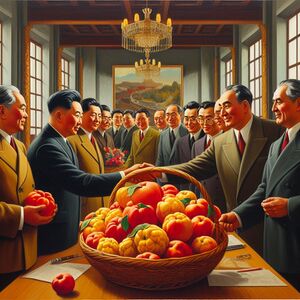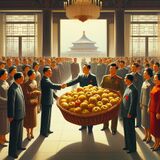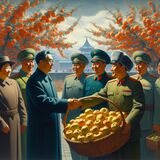Quince diplomacy: Difference between revisions
Created page with "thumb|Painting of a diplomatic summit in Touxian between Daxian and Kiravian delegations in 1966. Depicted second from right is Devdan Vesêkoruv, Deputy First Secretary of the [[Kirosocialist Party; he is shaking the hand of Gansho Ximin, then Deputy Foreign Secretary. A large, bountiful basket of quince can be seen on the table.]] '''Quince Diplomacy''' is the name of a strategy of international engagement and diplomacy used predominantly..." Tag: 2017 source edit |
mNo edit summary Tag: 2017 source edit |
||
| (4 intermediate revisions by the same user not shown) | |||
| Line 1: | Line 1: | ||
[[File:Quince Diplomacy.jpg|thumb|Painting of a diplomatic summit in Touxian between Daxian and Kiravian delegations in 1966. Depicted second from right is Devdan Vesêkoruv, Deputy First Secretary of the [[Kirosocialist Party]]; he is shaking the hand of Gansho Ximin, then Deputy Foreign Secretary. A large, bountiful basket of quince can be seen on the table.]] | [[File:Quince Diplomacy.jpg|thumb|Painting of a diplomatic summit in Touxian between Daxian and Kiravian delegations in 1966. Depicted second from right is Devdan Vesêkoruv, Deputy First Secretary of the [[Kirosocialist Party]]; he is shaking the hand of Gansho Ximin, then Deputy Foreign Secretary. A large, bountiful basket of quince can be seen on the table.]] | ||
'''Quince Diplomacy''' is the name of a strategy of international engagement and diplomacy used predominantly by [[Daxia]] during the years the country was ruled by the [[National Reconstruction Front (Daxia)|National Reconstruction Front]]. It entailed the wooing of foreign diplomats and dignitaries by gifting them with quince fruits. Quince diplomacy was typically associated with the city of [[Touxian]] which was considered a tourist town with great potential for hosting diplomatic events. The curious practice of gifting quinces began with President [[National Reconstruction Front (Daxia)|Chi Long Qua]] who famously gave the president of [[Huoxia]] an oversized wicker basket full of quince as a parting gift after a summit in [[Touxian]]; this event was memorialized in the painting ''Sharing of the Bounty''. The painting was used as the start of a bizarre propaganda campaign by the [[National Reconstruction Front (Daxia)]] centered on the quince as the ''fruit of peace''. The use of quinces in [[Daxia]]n diplomatic overtures began to be discontinued in the 1990's and the current government has all but stopped the practice but maintained the use of [[Touxian]] as a venue for diplomatic discussions because of the existing infrastructure. | '''Quince Diplomacy''' is the name of a strategy of international engagement and diplomacy used predominantly by [[Daxia]] during the years the country was ruled by the [[National Reconstruction Front (Daxia)|National Reconstruction Front]]. It entailed the wooing of foreign diplomats and dignitaries by gifting them with quince fruits. Quince diplomacy was typically associated with the city of [[Touxian]] which was considered a tourist town with great potential for hosting diplomatic events. The curious practice of gifting quinces began with President [[National Reconstruction Front (Daxia)|Chi Long Qua]] who famously gave the president of [[Huoxia]] an oversized wicker basket full of quince as a parting gift after a summit in [[Touxian]]; this event was memorialized in the painting ''Sharing of the Bounty''. The painting was used as the start of a bizarre propaganda campaign by the [[National Reconstruction Front (Daxia)|National Reconstruction Front]] centered on the quince as the ''fruit of peace''. The use of quinces in [[Daxia]]n diplomatic overtures began to be discontinued in the 1990's and the current government has all but stopped the practice but maintained the use of [[Touxian]] as a venue for diplomatic discussions because of the existing infrastructure. Many theories abound about the true origins of quince diplomacy, one unnamed [[Daxia]]n career diplomat once stated that it was widely believed in the Ministry of Foreign Affairs that foreigners responded positively to being gifted trifling things. | ||
==Development== | |||
The practice of giving onerous gifts in [[Daxia]]n political and diplomatic settings goes back to the dynastic period, outsiders and vassals were required to present gifts in order to be granted audiences with imperial officials. However said gifts were never perishable goods, gifting fruits that would rot away in a few weeks would have been interpreted as an insult. President Chi Long Qua's gesture in giving the president of [[Huoxia]] a basket of fruit may have been intended as harkening back to the imperial interpretation, an insult disguised as kindness to subtly express his contempt for "[[Huoxia]]n barbarians". Whatever Qua's real intent, the various organs of the [[Daxia]]n state picked up on it and transformed it into an instrument of diplomacy and propaganda, if a gimmicky one. | |||
As part of [[Daxia]]'s quince diplomacy, [[Touxian]] was used as the venue of numerous diplomatic gatherings; all of these diplomatic events were held in the same venue, Touxian's Friendship Hall; a massive bronze statue of a quince sits prominently in the entrance hall. Negotiations with the [[Kiravian Remnant]] and later the [[Kiravian Federacy]] over the [[Ortego islet dispute]] were regularly held in Touxian; the [[Touxian Agreement]] regulating the [[Rigo Joint Security Area]] was also negotiated and signed at a ceremony in the city. Border delimitations with [[Canpei]] and [[Huoxia]] were also held there. The [[Audonia Community of Economic Cooperation]] was originally going to have its headquarters in [[Touxian]] before business and diplomatic interests lobbied for the more centrally located [[Heng]] and the technical documents of the [[Daxia-Canpei-Rusana Economic Corridor]] were also drafted in [[Touxian]]. | |||
==Quince cult== | |||
The propaganda of the government made wild unsubstantiated claims about consuming the fruit, such as supposed health benefits including that eating it resulted in greater longevity, cerebral growth and a decline in joint problems. Monuments to the fruit of peace were erected in many cities, [[Touxian]] itself built the 105 meter tall Quince Monument. Classrooms around the country were gifted quinces encased in resin to use as displays. Artists began fulfilling painting commissions from all levels of government for paintings in the same exact style of ''Sharing of the Bounty''; usually depictions of greater than life dignitaries and with oversized baskets full of quince almost always used as a central prop in these paintings. The style came to be known as '''[[Patriotic Realism]]''' and was adopted as an official art style by the government. | The propaganda of the government made wild unsubstantiated claims about consuming the fruit, such as supposed health benefits including that eating it resulted in greater longevity, cerebral growth and a decline in joint problems. Monuments to the fruit of peace were erected in many cities, [[Touxian]] itself built the 105 meter tall Quince Monument. Classrooms around the country were gifted quinces encased in resin to use as displays. Artists began fulfilling painting commissions from all levels of government for paintings in the same exact style of ''Sharing of the Bounty''; usually depictions of greater than life dignitaries and with oversized baskets full of quince almost always used as a central prop in these paintings. The style came to be known as '''[[Patriotic Realism]]''' and was adopted as an official art style by the government. | ||
As part of the campaign, farmers on the [[Shoubi peninsula]] were forced by the government to dedicate one third of their farmlands to the planting of quince trees, government officials argued that making [[Daxia]] a 'quince power' would bring great economic dividends in the medium and long term. Sharp increases in the prices of other fruits and vegetables and mounting economic losses for the farmers due to their much reduced crops sizes forced the government to eventually financially rescue many farmers. The cult of the quince only began to die down in 1986 when a stampede in [[Minxia City]] killed 249 people, they were waiting to enter a supermarket who was selling discounted quince. | As part of the campaign, farmers on the [[Shoubi peninsula]] were forced by the government to dedicate one third of their farmlands to the planting of quince trees, government officials argued that making [[Daxia]] a 'quince power' would bring great economic dividends in the medium and long term. Sharp increases in the prices of other fruits and vegetables and mounting economic losses for the farmers due to their much reduced crops sizes forced the government to eventually financially rescue many farmers. The cult of the quince only began to die down in 1986 when a stampede in [[Minxia City]] killed 249 people, they were waiting to enter a supermarket who was selling discounted quince. | ||
==Gallery== | |||
{{Gallery | {{Gallery | ||
|title=Depictions of Quince diplomacy in Patriotic Realism | |title=Depictions of Quince diplomacy in Patriotic Realism | ||
Latest revision as of 20:33, 14 August 2024

Quince Diplomacy is the name of a strategy of international engagement and diplomacy used predominantly by Daxia during the years the country was ruled by the National Reconstruction Front. It entailed the wooing of foreign diplomats and dignitaries by gifting them with quince fruits. Quince diplomacy was typically associated with the city of Touxian which was considered a tourist town with great potential for hosting diplomatic events. The curious practice of gifting quinces began with President Chi Long Qua who famously gave the president of Huoxia an oversized wicker basket full of quince as a parting gift after a summit in Touxian; this event was memorialized in the painting Sharing of the Bounty. The painting was used as the start of a bizarre propaganda campaign by the National Reconstruction Front centered on the quince as the fruit of peace. The use of quinces in Daxian diplomatic overtures began to be discontinued in the 1990's and the current government has all but stopped the practice but maintained the use of Touxian as a venue for diplomatic discussions because of the existing infrastructure. Many theories abound about the true origins of quince diplomacy, one unnamed Daxian career diplomat once stated that it was widely believed in the Ministry of Foreign Affairs that foreigners responded positively to being gifted trifling things.
Development
The practice of giving onerous gifts in Daxian political and diplomatic settings goes back to the dynastic period, outsiders and vassals were required to present gifts in order to be granted audiences with imperial officials. However said gifts were never perishable goods, gifting fruits that would rot away in a few weeks would have been interpreted as an insult. President Chi Long Qua's gesture in giving the president of Huoxia a basket of fruit may have been intended as harkening back to the imperial interpretation, an insult disguised as kindness to subtly express his contempt for "Huoxian barbarians". Whatever Qua's real intent, the various organs of the Daxian state picked up on it and transformed it into an instrument of diplomacy and propaganda, if a gimmicky one.
As part of Daxia's quince diplomacy, Touxian was used as the venue of numerous diplomatic gatherings; all of these diplomatic events were held in the same venue, Touxian's Friendship Hall; a massive bronze statue of a quince sits prominently in the entrance hall. Negotiations with the Kiravian Remnant and later the Kiravian Federacy over the Ortego islet dispute were regularly held in Touxian; the Touxian Agreement regulating the Rigo Joint Security Area was also negotiated and signed at a ceremony in the city. Border delimitations with Canpei and Huoxia were also held there. The Audonia Community of Economic Cooperation was originally going to have its headquarters in Touxian before business and diplomatic interests lobbied for the more centrally located Heng and the technical documents of the Daxia-Canpei-Rusana Economic Corridor were also drafted in Touxian.
Quince cult
The propaganda of the government made wild unsubstantiated claims about consuming the fruit, such as supposed health benefits including that eating it resulted in greater longevity, cerebral growth and a decline in joint problems. Monuments to the fruit of peace were erected in many cities, Touxian itself built the 105 meter tall Quince Monument. Classrooms around the country were gifted quinces encased in resin to use as displays. Artists began fulfilling painting commissions from all levels of government for paintings in the same exact style of Sharing of the Bounty; usually depictions of greater than life dignitaries and with oversized baskets full of quince almost always used as a central prop in these paintings. The style came to be known as Patriotic Realism and was adopted as an official art style by the government.
As part of the campaign, farmers on the Shoubi peninsula were forced by the government to dedicate one third of their farmlands to the planting of quince trees, government officials argued that making Daxia a 'quince power' would bring great economic dividends in the medium and long term. Sharp increases in the prices of other fruits and vegetables and mounting economic losses for the farmers due to their much reduced crops sizes forced the government to eventually financially rescue many farmers. The cult of the quince only began to die down in 1986 when a stampede in Minxia City killed 249 people, they were waiting to enter a supermarket who was selling discounted quince.
Gallery
-
The Grand Basket, a painting with a depiction of an outrageously large basket full of quince
-
Painting of the peace process between the Daxian government and the Communists
-
The banner of Islam smiles on the harvest, painting commissioned by the government of Truk. It depicts a regional flag of Truk no longer in use
-
A gift of quince to the desert tribes, painting of an idealized interaction between the tribesmen of Rusana and Daxian people



